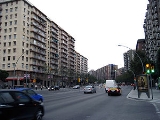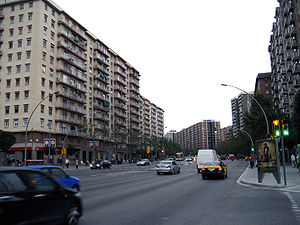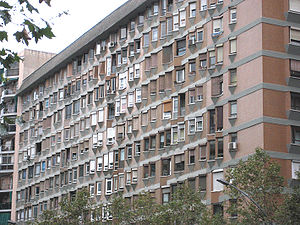
Avinguda Meridiana, Barcelona
Encyclopedia



Barcelona
Barcelona is the second largest city in Spain after Madrid, and the capital of Catalonia, with a population of 1,621,537 within its administrative limits on a land area of...
, Spain
Spain
Spain , officially the Kingdom of Spain languages]] under the European Charter for Regional or Minority Languages. In each of these, Spain's official name is as follows:;;;;;;), is a country and member state of the European Union located in southwestern Europe on the Iberian Peninsula...
, spanning parts of the Sant Andreu
Sant Andreu
Sant Andreu is one of the ten districts into which Barcelona has been divided up since 1984. It was named after a former municipality in the plain of Barcelona called Sant Andreu de Palomar, the largest in the area, which makes up nowadays the bulk of a neighbourhood bearing the same name...
, Nou Barris
Nou Barris
Nou Barris is one of the ten districts into which Barcelona has been officially divided since 1984. The name refers to the original nine neighbourhoods it was composed of, even though nowadays it's made up of fourteen...
and Sant Martí
Sant Martí
Sant Martí , is a district of Barcelona located on its eastern side, usually numbered 10 out of the ten districts of the city.It borders the Mediterranean sea, Sant Adrià del Besòs and four other districts of the city: Ciutat Vella, l'Eixample, Horta-Guinardó and Sant Andreu.It did not become an...
northern districts of the city
Districts of Barcelona
Barcelona, Catalonia, Spain proper is presently divided into 10 districts. These are administrated by a councillor designated by the main city council, and each of them have some powers relating to issues such as urbanism or infrastructure in their area. The current division of the city into...
. Originally planned by Ildefons Cerdà
Ildefons Cerdà
Ildefons Cerdà i Sunyer was the progressive Catalan Spanish urban planner who designed the 19th-century "extension" of Barcelona called the Eixample.-Biography:...
in 1859 to be one of the two most important thoroughfares in Barcelona, its actual role hasn't been exactly so but still has become a much transited route linking Parc de la Ciutadella
Parc de la Ciutadella
The Parc de la Ciutadella is a park in Ciutat Vella, Barcelona, Spain. After its establishment during the mid 19 century, it was for decades the only green area in the city, and hitherto of the most popular...
with northern parts of Barcelona, crossing Plaça de les Glòries in its way, where it meets other two major avenues: Gran Via de les Corts Catalanes and Avinguda Diagonal. It absorbs the traffic coming from the AP-7
Autopista AP-7
The Autopista AP-7 is a Spanish autopista . It is a toll motorway that runs along the Mediterranean coast of Spain.AP-7 has two different sections :...
motorway, which makes it a densely transited area. The avenue goes through the following neighbourhoods of Barcelona: El Clot
El Clot
El Clot is a neighborhood in the Sant Martí district of Barcelona, Catalonia . It is one of the oldest parts of the district as it existed in medieval times under the name Clotum Melis . It was one of the parts of the former municipality of Sant Martí de Provençals, as it were the current...
, Navas
Navas
Navas is a neighborhood in the Sant Andreu district of Barcelona, Catalonia .-References:...
, La Sagrera
La Sagrera
La Sagrera is a neighborhood in the Sant Andreu district of Barcelona, Catalonia ....
, Sant Andreu de Palomar
Sant Andreu de Palomar
Sant Andreu de Palomar is a neighborhood in the Sant Andreu district of Barcelona, Catalonia . It was the main core of the former municipality of Sant Andreu de Palomar that more or less coincides with what is now the district of Sant Andreu....
, El Congrés i els Indians
El Congrés i els Indians
El Congrés i els Indians is a neighborhood in the Sant Andreu district of Barcelona, Catalonia ....
, Vilapicina
Vilapicina i Torre Llobeta
Vilapicina i Torre Llobeta is a neighborhood in the Nou Barris district of Barcelona, Catalonia ....
, Porta
Porta, Barcelona
Porta is a neighborhood in the Nou Barris district of Barcelona, Catalonia ....
, La Prosperitat
La Prosperitat
La Prosperitat is a neighborhood in the Nou Barris district of Barcelona, Catalonia ....
, Trinitat Nova
Trinitat Nova
Trinitat Nova is a neighborhood in the Nou Barris district of Barcelona, Catalonia ....
, Trinitat Vella
Trinitat Vella
Trinitat Vella is a neighborhood in the Sant Andreu district of Barcelona, Catalonia ....
and Vallbona
Vallbona, Barcelona
Vallbona is a neighborhood in the Nou Barris district of Barcelona, Catalonia ....
, largely working-class areas of the city.
Architecturally, the area is blunt and lacking in aesthetic pretention, but includes a few significant apartment blocks such as the Meridiana tower blocks by Oriol Bohigas
Oriol Bohigas
Oriol Bohigas i Guardiola is a Catalan Spanish architect and urban planner. He is partner in the architecture office MBM.From 1980 until 1984 he has been the Director of Planning of the City of Barcelona....
, Josep Maria Martorell and David Mackay
David Mackay (architect)
David Mackay is a British architect and partner in MBM . He was active in Catalonia, where he worked on the design for the renovation of the port area of Barcelona and the construction of the Olympic Village there in 1992....
. Avinguda Meridiana symbolizes instrumental urbanism, being little more than an urban motorway, and very different from Barcelona's main avenues and boulevards.
On 19 June 1987, the Basque
Basque people
The Basques as an ethnic group, primarily inhabit an area traditionally known as the Basque Country , a region that is located around the western end of the Pyrenees on the coast of the Bay of Biscay and straddles parts of north-central Spain and south-western France.The Basques are known in the...
separatist group ETA
ETA
ETA , an acronym for Euskadi Ta Askatasuna is an armed Basque nationalist and separatist organization. The group was founded in 1959 and has since evolved from a group promoting traditional Basque culture to a paramilitary group with the goal of gaining independence for the Greater Basque Country...
planted a bomb
1987 Hipercor bombing
The 1987 Hipercor bombing was a car bomb attack by the Basque separatist organisation ETA which occurred on 19 June 1987 at the Hipercor shopping centre on Avinguda Meridiana, Barcelona, Spain. The bombing killed 21 people and injured 45 people.-Background:...
in the basement of a Hipercor
Hipercor
Hipercor S.A. is an up-scale chain of hypermarkets in Spain, belonging to the same group as El Corte Inglés. It has its head office in the El Corte Inglés head office building in Madrid....
hypermarket
Hypermarket
In commerce, a hypermarket is a superstore combining a supermarket and a department store. The result is an expansive retail facility carrying a wide range of products under one roof, including full groceries lines and general merchandise...
in this avenue that killed 21 people. 41 were injured.
Metro stations
- Torras i BagesTorras i Bages (Barcelona Metro)Torras i Bages is a station of the Barcelona Metro, on L1 . Opened in 1968, it serves the northern part of the Sant Andreu de Palomar neighbourhood in the Sant Andreu district, and was one of the termini of this subway line until 1983, when it was extended into Santa Coloma. The station doesn't...
(L1Barcelona Metro line 1— Line 1, shortened to L1 and known as "Hospital de Bellvitge - Fondo", coloured red and often simply called Línia vermella , is the second oldest metro line in Barcelona, after L3. It is operated by Transports Metropolitans de Barcelona . It appeared as a means to join the rail stations the city...
) - Fabra i PuigFabra i Puig (Barcelona Metro)Fabra i Puig is a Barcelona Metro station, on L1 , located in the Sant Andreu district of Barcelona, below Avinguda Meridiana between Carrer de Concepció Arenal i Passeig de Fabra i Puig. It opened in 1954, with the extension of the aforementioned line from Sagrera to this station. Passengers can...
(L1Barcelona Metro line 1— Line 1, shortened to L1 and known as "Hospital de Bellvitge - Fondo", coloured red and often simply called Línia vermella , is the second oldest metro line in Barcelona, after L3. It is operated by Transports Metropolitans de Barcelona . It appeared as a means to join the rail stations the city...
) - Sagrera-Meridiana (L1Barcelona Metro line 1— Line 1, shortened to L1 and known as "Hospital de Bellvitge - Fondo", coloured red and often simply called Línia vermella , is the second oldest metro line in Barcelona, after L3. It is operated by Transports Metropolitans de Barcelona . It appeared as a means to join the rail stations the city...
, L4Barcelona Metro line 4— Line 4, currently known as Trinitat Nova – La Pau, usually called "línia groga" , is a line in the Barcelona Metro network operated by TMB, and part of the ATM fare-integrated transport network...
, L5Barcelona Metro line 5— Line 5, currently known as Cornellà Centre - Vall d'Hebron, its termini, and often simply called "Línia Blava" is line belonging to the Barcelona Metro network operated by TMB, and part of the ATM fare-integrated transport network....
, L9Barcelona Metro line 9Line 9 is a line of the Barcelona Metro network that is currently under construction, with five stations open in the Santa Coloma de Gramenet suburb since December 2009...
, L10Barcelona Metro line 10Line 10 is the name of one of the two branches of the Barcelona metro extension line 9, currently under construction and to be operated by TMB.-Overview:...
) - NavasNavas (Barcelona Metro)Navas is a Barcelona Metro station located in the Sant Andreu district of Barcelona, served by L1. It opened in 1953. The name refers to carrer Navas de Tolosa, and the station was originally called Navas de Tolosa until it adopted its current name in 1982....
(L1Barcelona Metro line 1— Line 1, shortened to L1 and known as "Hospital de Bellvitge - Fondo", coloured red and often simply called Línia vermella , is the second oldest metro line in Barcelona, after L3. It is operated by Transports Metropolitans de Barcelona . It appeared as a means to join the rail stations the city...
) - ClotClot (Barcelona Metro)Clot is a station serving line 1 and line 2 of the Barcelona Metro.The Line 1 station, opened in 1951, was built below Avinguda Meridiana between Carrer Aragó and Carrer València, and is arranged according to the Spanish solution with both side and central platforms...
(L1Barcelona Metro line 1— Line 1, shortened to L1 and known as "Hospital de Bellvitge - Fondo", coloured red and often simply called Línia vermella , is the second oldest metro line in Barcelona, after L3. It is operated by Transports Metropolitans de Barcelona . It appeared as a means to join the rail stations the city...
, L2Barcelona Metro line 1— Line 1, shortened to L1 and known as "Hospital de Bellvitge - Fondo", coloured red and often simply called Línia vermella , is the second oldest metro line in Barcelona, after L3. It is operated by Transports Metropolitans de Barcelona . It appeared as a means to join the rail stations the city...
) - GlòriesGlòries (Barcelona Metro)Glòries is the name of a station in the Barcelona metro system, located underground of Plaça de les Glòries Catalanes, and served by L1. It was opened in 1951, when Line 1 was extended from Marina to Clot. It can be accessed from carrer d'Àlaba and Glòries. It is currently being adapted for...
(L1Barcelona Metro line 1— Line 1, shortened to L1 and known as "Hospital de Bellvitge - Fondo", coloured red and often simply called Línia vermella , is the second oldest metro line in Barcelona, after L3. It is operated by Transports Metropolitans de Barcelona . It appeared as a means to join the rail stations the city...
, T4, T5) - MarinaMarina (Barcelona Metro)Marina is the name of a station in the Barcelona metro network, served by TMB line L1. It's named after Carrer de la Marina, in the edge of two districts: Eixample and Sant Martí.It was opened in 1933...
(L1Barcelona Metro line 1— Line 1, shortened to L1 and known as "Hospital de Bellvitge - Fondo", coloured red and often simply called Línia vermella , is the second oldest metro line in Barcelona, after L3. It is operated by Transports Metropolitans de Barcelona . It appeared as a means to join the rail stations the city...
)
Train stations
- Sant Andreu Arenal, interconnected with Fabra i Puig metro station. (R3, R4), Rodalies Barcelona line R7, Ca1, Ca2, Ca3, Ca4, Ca6, R42)
- Clot-Aragó, interconnected with Clot metro station, (R1, R2, Ca1, Ca2, Ca3, Ca4, Ca6, R42)

